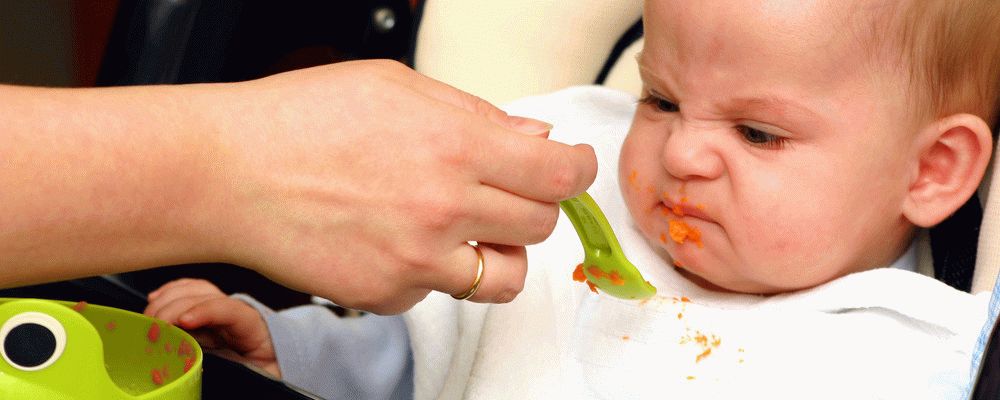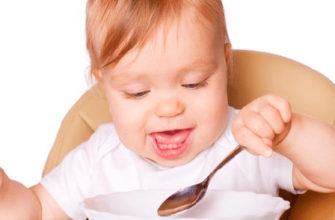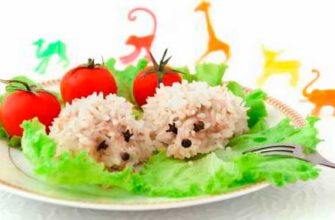 The first four months, the baby was fed exclusively breast milk or mixtures. The time has come for the first feeding, since by the fifth to sixth month the baby will no longer have enough nutrients for the full growth of milk. By the first half of the year, the mucous membrane of the baby’s neck can already adapt to swallowing solid particles of food.
The first four months, the baby was fed exclusively breast milk or mixtures. The time has come for the first feeding, since by the fifth to sixth month the baby will no longer have enough nutrients for the full growth of milk. By the first half of the year, the mucous membrane of the baby’s neck can already adapt to swallowing solid particles of food.
It is worth introducing the first complementary foods for the baby only when he gains weight twice as much as at birth and will sit stably. Be sure the baby should have the so-called “food interest”, he should be interested in the food that other family members consume.
We teach the baby to new food
It is better to start feeding your baby with mashed vegetables. It has all the necessary advantages for a new baby’s nutrition:
- The diverse composition of mineral salts necessary for the growing skeleton of the baby.
- A large number of vitamins and biostimulants.
- Plant fiber, which regulates bowel function.
- The content of alkaline salts necessary for a good metabolism, improved breathing, tonicity of the nervous system and removal of excess water.
- The lack of sweets will help the baby better perceive the second complementary foods - porridge.
- The content of dense lumps in mashed potatoes will prepare a throat for swallowing solid food.
It is necessary to accustom the child to complementary feeding gradually. We start with one or two spoons before the second or third breastfeeding. In mashed potatoes, in addition to vegetables, you can add half the yolk and a little vegetable oil. For a month, the amount of mashed potatoes is brought to 150 g (three quarters of a glass) and one breast-feeding is completely replaced. You can divide the lure into several stages. It is important that the baby enjoys the meal.
Innovations in nutrition often do not go smoothly, sometimes a child does not want to eat complementary foods. Of course, not all children readily join new food. The taste buds in infants are well developed and from birth they get used to the sweet taste of milk. It is important to immediately establish contact with the baby with respect to food, otherwise further feeding will turn into torture on both sides.
What to do if a child refuses to eat complementary foods
So, the first and second attempt to feed the baby failed.The child does not want to eat complementary foods and what to do if he spits out food or even starts to tear it.
- Firstly, gag reflexes don't be afraid. At this time, they are of functional origin. Most often, vomiting occurs when the lactation period is prolonged.
- Secondly, the desires and tastes of the baby must be taken into account, but still affectionately insist on their own.Taste can be developed not by coercion, but by the use of small pedagogical tricks.
[sc: rsa]
Here are some practical tips if your baby doesn't want to eat complementary foods:
- give a new type of nutrition on an empty stomach;
- observe a diet - the baby should be hungry;
- first, slightly sweeten the puree with breast milk or a mixture;
- find out the taste preferences of the baby: some children eat mashed potatoes better, others from Brussels sprouts, and the third serve a mix of different vegetables;
- if the baby did not like the new dish, do not insist, try to offer another dish, and return to this in ten days;
- introduce new products gradually, for one week they are fed with one type of mashed potatoes and then they try a new one;
- put the baby at the table during a family meal, show and tell how you eat with pleasure. Give him a few grains from your plate, let him try;
- the most important thing is no violence, it’s not scary if once the baby remains hungry, it’s better to eat little, but with pleasure;
It just happens, the child feels bad: teeth are cut or tummy ache therefore, he refuses to eat complementary foods.
No need to distract the baby with toys or try to feed unnoticed. In the first case, the formation of the wrong habit of eating at the game will begin. Invisible feeding will not bring any benefit to a small organism. When the baby does not want to eat, the salivation in the mouth and the production of gastric juice are reduced, and the food is poorly digested.
He doesn’t want to eat from a spoon
 You need to start feeding your baby solid food using a spoon. It is good if it is a silver product (silver prevents the development of microbes), but a spoonful of plastic is also suitable (plastic spoons are safe for the child, and due to the bright colors they attract attention, so the baby will be happy to eat with it).
You need to start feeding your baby solid food using a spoon. It is good if it is a silver product (silver prevents the development of microbes), but a spoonful of plastic is also suitable (plastic spoons are safe for the child, and due to the bright colors they attract attention, so the baby will be happy to eat with it).
In size, it is better to take a coffee first, then go to the tea room.
The sooner the baby gets acquainted with cutlery, the less problems with complementary foods. Preferably from the third month give some water drink only from a spoon. If the child does not want to eat complementary foods from a spoon, then during training for a spoon, you should not feed him from the nipple, it is better to let the baby first take food with his hands, let him try to eat himself. Then give a spoon. The child and everything around will be smeared, but to clean everything is much easier than to suffer further. Gradually, the baby will get used to the spoon and eat it well.
We read the article:How to teach a child to eat with a spoon
See video:
Doesn't want to eat porridge
A small family member begins to give porridge from 6 to 7 months. First, one teaspoon of buckwheat, rice or corn. Gradually, the volume of complementary foods increases to 150 g, and the range of cereals expands. Cook porridge for a six-month-old baby should be on water or a decoction of vegetables, without adding milk and sugar.
Feeding is not always a substitute for breastfeeding, but only a necessary supplement to the full nutrition of the baby. This is a familiarity with “adult” food. It's okay if the child flatly refuses mashed potatoes and cereal. Be patient. Watch the baby, because in this case he is the main adviser.
On the topic of complementary foods:
- Enter: GF food;
- Enter: Prikom on IV.










Nothing new, just platitudes. Especially ridiculed the trick to add breast milk to complementary foods. Yes, all the complementary foods are prepared in breast milk in my case. All these methods have already been tried, the child still in almost 10 months refuses any kind of food. All children are different, universal advice does not exist. In my experience with the first child, the only way to get the child to eat is through simultaneous weaning.
Nothing to learn. Everything comes with age. My daughter grew up without any appetite. Such an impression was made that she was eating air. I even roared when I fed her. Now grown, and the appetite is wonderful.
She worked in a manger, they didn’t teach one child to eat with a spoon, they gave her to the garden, she ate meatballs with her hands, she drank soup like compote. As we did not fight, I did not perceive a spoon at all. If you do not accustom time, then there will be such problems.
I’m now 2, eating only what he likes with a spoon: macaroni, buckwheat porridge, cutlet and scrambled eggs even with a fork picks successfully. But the soup is not very. I think we need to put the child at the common table more often so that I can see how mom and dad eat. And do not really insist, do not want to now - eat in an hour, hungry.
It’s written here: start feeding only if the baby is sitting well. And it’s written that from 5 months there is already not enough nutrients. So it’s nothing that many children sit confidently much later: at 8 months, for example. do not feed up to 8 months? and if at 6 months there is still no food interest. and insist, and at the same time do not insist a lot of contradictions.
Absolutely illiterate article, like much on this site. What the baby lacks in 5 months of the nutrients of breast milk is the author’s gaze. WHO recommends EXCLUSIVELY GW for at least 6 months! complementary foods have long been recommended to be administered between 6 and 8 months.
And my child eats vegetable and fruit purees perfectly, but refuses cereals, they have already tried rice, buckwheat and corn, made both on breast milk and on the mixture, thicker and thinner, even added applesauce, hysteria and turns away.
Why are you all negative! Then wonder why the child does not eat!
And about complementary foods, everyone has a different way! I have a tall child, at 4 months weighed almost 8 kg and a height of 75 cm! The appetite is atrocious, it required a breast every hour, so the pediatrician said to introduce complementary foods!
And you all row by yourself and your child!
But I gave water to prikrm only after the bath, and then only a teaspoon!)))))